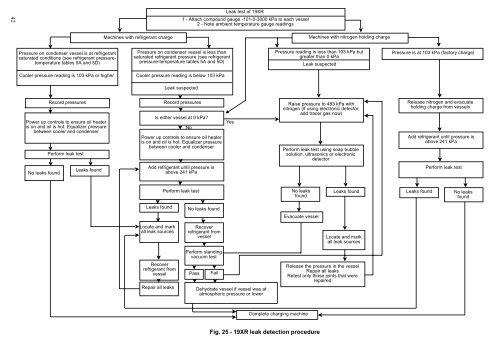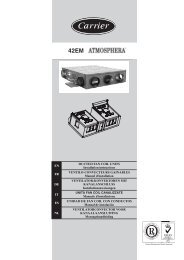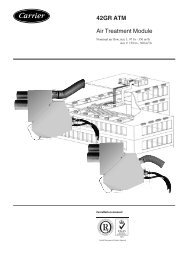19XR (PIC II) Hermetic Centrifugal Liquid Chillers 50 Hz - Carrier
19XR (PIC II) Hermetic Centrifugal Liquid Chillers 50 Hz - Carrier
19XR (PIC II) Hermetic Centrifugal Liquid Chillers 50 Hz - Carrier
You also want an ePaper? Increase the reach of your titles
YUMPU automatically turns print PDFs into web optimized ePapers that Google loves.
42<br />
Pressure on condenser vessel is at refrigerant<br />
saturated conditions (see refrigerant pressuretemperature<br />
tables 5A and 5D)<br />
Cooler pressure reading is 103 kPa or higher<br />
Record pressures<br />
Power up controls to ensure oil heater<br />
is on and oil is hot. Equalizer pressure<br />
between cooler and condenser<br />
No leaks found<br />
Perform leak test<br />
Leaks found<br />
Machines with refrigerant charge<br />
Leak test of <strong>19XR</strong><br />
1 - Attach compound gauge -101-0-3000 kPa to each vessel<br />
2 - Note ambient temperature gauge readings<br />
Pressure on condenser vessel is less than<br />
saturated refrigerant pressure (see refrigerant<br />
pressure-temperature tables 5A and 5D)<br />
Cooler pressure reading is below 103 kPa<br />
Leak suspected<br />
Record pressures<br />
Is either vessel at 0 kPa?<br />
Power up controls to ensure oil heater<br />
is on and oil is hot. Equalizer pressure<br />
between cooler and condenser<br />
Add refrigerant until pressure is<br />
above 241 kPa<br />
Leaks found<br />
Locate and mark<br />
all leak sources<br />
Recover<br />
refrigerant from<br />
vessel<br />
Repair all leaks<br />
No<br />
Perform leak test<br />
No leaks found<br />
Recover<br />
refrigerant from<br />
vessel<br />
Perform standing<br />
vacuum test<br />
Pass<br />
Fail<br />
Yes<br />
Dehydrate vessel if vessel was at<br />
atmospheric pressure or lower<br />
Fig. 25 - <strong>19XR</strong> leak detection procedure<br />
Machines with nitrogen holding charge<br />
Pressure reading is less than 103 kPa but<br />
greater than 0 kPa<br />
Leak suspected<br />
Raise pressure to 483 kPa with<br />
nitrogen (if using electronic detector,<br />
add tracer gas now)<br />
Perform leak test using soap bubble<br />
solution, ultrasonics or electronic<br />
detector<br />
No leaks<br />
found<br />
Evacuate vessel<br />
Complete charging machine<br />
Leaks found<br />
Locate and mark<br />
all leak sources<br />
Release the pressure in the vessel<br />
Repair all leaks<br />
Retest only those joints that were<br />
repaired<br />
Pressure is at 103 kPa (factory charge)<br />
Release nitrogen and evacuate<br />
holding charge from vessels<br />
Add refrigerant until pressure is<br />
above 241 kPa<br />
Perform leak test<br />
Leaks found No leaks<br />
found




